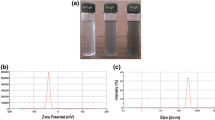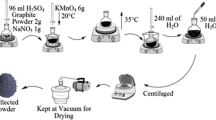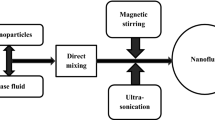Abstract
In this work, reduced graphene oxide (rGO) is synthesized from graphite powder and various characterization techniques have been used to study the in-plane crystallite size, number of layers, presence of functional groups and surface morphology. The rGO flakes are dispersed in Millipore water to obtain 0.0005, 0.001, and 0.002 wt.% of rGO-water nanofluids. It is then used in the experimental facility to study the nucleate boiling heat transfer with different heating surfaces viz. smooth and sandblasted surface (SBS). Results of this study indicate (i) an enhancement in heat transfer coefficient (HTC) for concentration upto 0.001 wt.% and deterioration beyond this in the case of smooth surface, and (ii) an increase in HTC with concentrations is observed for SBS and shows a maximum enhancement of about 60% in comparison with smooth surface at 0.002 wt.%. It is found that the presence of secondary cavities (acts as nucleation sites) formed by the rGO flakes during boiling is responsible for the observed phenomena in addition to the possible effect of rGO in the fluid flow.













Similar content being viewed by others
References
Luke A (1997) Pool boiling heat transfer from horizontal tubes with different surface roughness. Int J Refrig 20:561–574
Kang M-G (2000) Effect of surface roughness on pool boiling heat transfer. Int J Heat Mass Transf 43:4073–4085
McHale JP, Garimella SV (2010) Bubble nucleation characteristics in pool boiling of a wetting liquid on smooth and rough surfaces. Int J Multiphase Flow 36:249–260
Rajulu KG, Kumar R, Mohanty B, Varma HK (2004) Enhancement of nucleate pool boiling heat transfer coefficient by reentrant cavity surfaces. Heat Mass Transf 41:127–132
Inoue T, Monde M (1994) Nucleate pool boiling heat transfer in binary mixtures. Heat Mass Transf 29:171–180
Fantozzi F, Franco A, Latrofa EM (2000) Analysis of the heat dissipation enhancement with finned surfaces in pool boiling of dielectric fluid. Heat Mass Transf 36:487–495
Honda H, Wei JJ (2004) Enhanced boiling heat transfer from electronic components by use of surface microstructures. Exp Thermal Fluid Sci 28(2–3):159–169
Qu ZG, Xu ZG, Zhao CY, Tao WQ (2012) Experimental study of pool boiling heat transfer on horizontal metallic foam surface with crossing and single-directional V-shaped groove in saturated water. Int J Multiphase Flow 41:44–55
Wen MY, Ho CY (2003) Pool boiling heat transfer of deionized and degassed water in vertical/horizontal V-shaped geometries. Heat Mass Transf 39:729–736
Ustinov A, Ustinov V, Mitrovic J (2011) Pool boiling heat transfer of tandem tubes provided with the novel microstructures. Int J Heat Fluid Flow 32:777–784
Jo HJ, Kim SH, Park HS, Kim MH (2014) Critical heat flux and nucleate boiling on several heterogeneous wetting surfaces: controlled hydrophobic patterns on a hydrophilic substrate. Int J Multiphase Flow 62:101–109
Moita AS, Teodori E, Moreira ALN (2015) Influence of surface topography in the boiling mechanisms. Int J Heat Fluid Flow 52:50–63
Launay S, Fedorov A, Joshi Y, Cao A, Ajayan P (2006) Hybrid micro–nano structured thermal interface for pool boiling heat transfer enhancement. Microelectron J 37(11):1158–1164
Lee CY, Bhuiya MMH, Kim KJ (2010) Pool boiling heat transfer with nano-porous surface. Int J Heat Mass Transf 53:4274–4279
Lee CY, Zhang BJ, Kim KJ (2014) Influence of heated surfaces and fluids on pool boiling heat transfer. Exp Thermal Fluid Sci 59:15–23
Liu ZH, Xiong JG, Bao R (2007) Boiling heat transfer characteristics of nanofluids in a flat heat pipe evaporator with micro-grooved heating surface. Int J Multiphase Flow 33:1284–1295
Chopkar M, Das AK, Manna I, Das PK (2008) Pool boiling heat transfer characteristics of ZrO2–water nanofluids from a flat surface in a pool. Heat Mass Transf 44:999–1004
Prakash Narayan G, Anoop KB, Sateesh G, Das SK (2008) Effect of surface orientation on pool boiling heat transfer of nanoparticle suspensions. Int J Multiphase Flow 34:145–160
Vassallo P, Kumar R, D’Amico S (2004) Pool boiling heat transfer experiments in silica-water nano-fluids. Int J Heat Mass Transf 47:407–411
You SM, Kim JH, Kim KH (2003) Effect of nanoparticles on critical heat flux of water in pool boiling heat transfer. Appl Phys Lett 83:3374–3376
Das SK, Putra N, Roetzel W (2003) Pool boiling characteristics of nano-fluids. Int J Heat Mass Transf 46:851–862
Harish G, Emlin V, Sajith V (2011) Effect of surface particle interactions during pool boiling of nanofluids. Int J Therm Sci 50:2318–2327
Wen D, Corr M, Hu X, Lin G (2011) Boiling heat transfer of nanofluids: the effect of heating surface modification. Int J Therm Sci 50:480–485
Suriyawong A, Wongwises S (2010) Nucleate pool boiling heat transfer characteristics of TiO2–water nanofluids at very low concentrations. Exp Thermal Fluid Sci 34:992–999
Amiri A, Shanbedi M, Amiri H, Zeinali Heris S, Kazi SN, Chew BT, Eshghi H (2014) Pool boiling heat transfer of CNT/water nanofluids. Appl Therm Eng 71:450–459
Xu ZG, Zhao CY (2014) Influences of nanoparticles on pool boiling heat transfer in porous metals. Appl Therm Eng 65(1–2):34–41
Cieśliński JT, Kaczmarczyk TZ (2015) Pool boiling of water–Al2O3 and water–cu Nanofluids outside porous coated tubes. Heat Transf Eng 36(6):553–563
Niu G, Li J (2015) Comparative studies of pool boiling heat transfer with nano-fluids on porous surface. Heat Mass Transf 51:1769–1777
Seo H, Chu JH, Kwon S-Y, Bang IC (2015) Pool boiling CHF of reduced graphene oxide, graphene, and SiC-coated surfaces under highly wettable FC-72. Int J Heat Mass Transf 82:490–502
Hummers WS, Offeman RE (1958) Preparation of graphite oxide. J Am Chem Soc 80:1339
Holman JP (2001) Experimental methods for engineers, seventh edn. McGraw-Hill, New York (Chapter 3)
Kamatchi R, Venkatachalapathy S, Abinaya Srinivas B (2015) Synthesis, stability, transport properties, and surface wettability of reduced graphene oxide/water nanofluids. Int J Therm Sci 97:17–25
Subrahmanyam KS, Vivekchand SRC, Govindaraj A, Rao CNR (2008) A study of graphene prepared by different methods: characterization, properties and solubilization. J Mater Chem 18:1517–1523
Chakrabarti A, Lu J, Skrabutenas JC, Xu T, Xiao Z, Maguireb JA, Hosmane NS (2011) Conversion of carbon dioxide to few-layer graphene. J Mater Chem 21:9491–9493
Nen-Wen P, Wang C-A, Liu Y-M, Sung Y, Wang D-S, Ger M-D (2012) Dispersion of graphene in aqueous solutions with different types of surfactants and the production of graphene films by spray or drop coating. J Taiwan Inst Chem E 43:140–146
Dato A, Lee Z, Jeon K-J, Erni R, Radmilovic V, Richardsonc TJ, Frenklachd M (2009) Clean and highly ordered graphene synthesized in the gas phase. Chem Commun 40:6095–6097
Rohsenow WM (1952) A method of correlating heat transfer data for surface boiling of liquids. Trans ASME 74:969–975
Ahmed O, Hamed MS (2012) Experimental investigation of the effect of particle deposition on pool boiling of nanofluids. Int J Heat Mass Transf 55:3423–3436
Cooper MG (1984) Heat flow rates in saturated nucleate pool boiling-a wide ranging examination using reduced properties. Adv Heat Tran 16:157–239
Das SK, Putra N, Thiesen P, Roetzel W (2003) Temperature dependence of thermal conductivity enhancement for nanofluids. Trans ASME J Heat Transf 125:567–575
Kamatchi R, Venkatachalapathy S (2015) Parametric study of pool boiling heat transfer with nanofluids for the enhancement of critical heat flux: a review. Int J Therm Sci 87:228–240
Moreno G Jr (2005) Investigation of pool boiling heat transfer with nanofluids. University of Texas, Arlington, M. S Thesis
White SB (2010) Enhancement of boiling surfaces using nanofluid particle deposition. University of Michigan, Ph. D Thesis
Kole M, Dey TK (2012) Investigations on the pool boiling heat transfer and critical heat flux of ZnO-ethylene glycol nanofluids. Appl Therm Eng 37:112–119
Park SD, Wonlee S, Kang S, Bang IC, Kim JH, Shin HS, Lee DW, Won Lee D (2010) Effects of nanofluids containing graphene/graphene-oxide nanosheets on critical heat flux. Appl Phys Lett 97:023103–023103
Ahn HS, Kim JM, Kim MH (2013) Experimental study of the effect of a reduced graphene oxide coating on critical heat flux enhancement. Int J Heat Mass Transf 60:763–771
Kamatchi R, Venkatachalapathy S, Nithya C (2015) Experimental investigation and mechanism of critical heat flux enhancement in pool boiling heat transfer with nanofluids. Heat Mass Transf. https://doi.org/10.1007/s00231-015-1749-2
Benjamin RJ, Balakrishnan AR (1997) Nucleation site density in pool boiling of saturated pure liquids: effect of surface microroughness and surface and liquid physical properties. Exp Thermal Fluid Sci 15:32–42
Youngjae Park, Hyungmo Kim, Joonwon Kim, Hyungdae Kim, Measurement of liquid-vapor phase distribution on nano- and microstructured boiling surfaces https://doi.org/10.1016/j.ijmultiphaseflow.2016.01.007
Ganapathy H, Sajith V (2013) Semi analytical model of pool boiling of nanofluids. Int J Heat Mass Transf 53:32–47
Author information
Authors and Affiliations
Corresponding author
Rights and permissions
About this article
Cite this article
Kamatchi, R. Experimental investigations on nucleate boiling heat transfer of aqua based reduced graphene oxide nanofluids. Heat Mass Transfer 54, 437–451 (2018). https://doi.org/10.1007/s00231-017-2135-z
Received:
Accepted:
Published:
Issue Date:
DOI: https://doi.org/10.1007/s00231-017-2135-z




